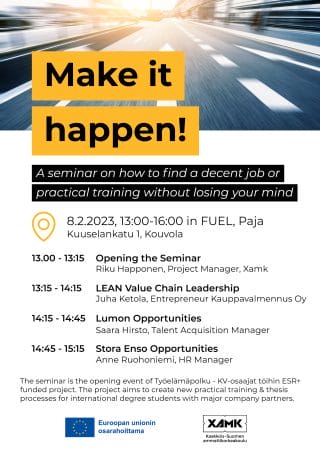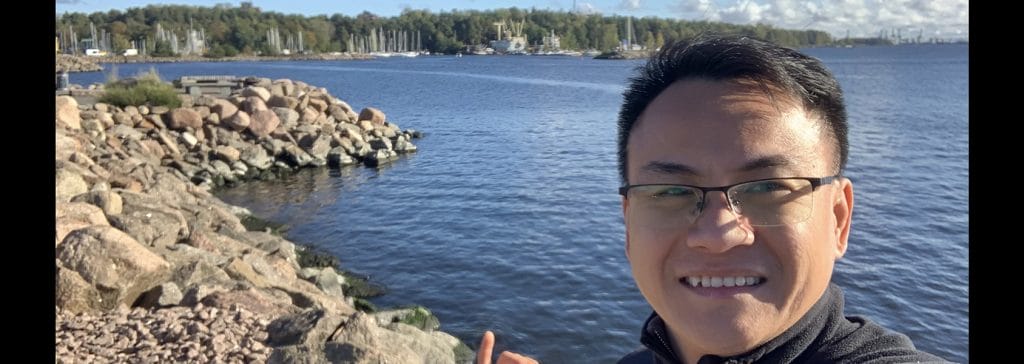

Work Life Path
International experts to work
The project promoted international recruitment, particularly in exporting companies of Kymenlaakso region.
International student of today is the international expert of tomorrow.
Solutions to skill shortage
International degree students do not often have a professional network to help them to integrate with the Finnish working life and companies in the region after the completion of their studies.
This project seeked a solution to the challenges in recruitment from the perspectives of both international students and companies by co-creating together with students and companies a working life path designed, piloted and documented in 2-4 different industries.
These paths contributed to the development of integration of students into Finnish working life and companies in the Kymenlaakso region.

We solve Kymenlaakso’s talent shortage by promoting international recruitment in companies in the area.
Work Life Path Handbook
This handbook consists of the results, experiences, and pilots made during the project.
Work Life Path Handbook is also available in Finnish as a PDF here.
The Work Life Path – International Experts to Work aimed to improve the confluence between companies and international students in the Kymenlaakso region. According to a study by the Chamber of Commerce (January 2022), only 35% of respondents had collaborated with international students, even though at the same time companies were experiencing a shortage of skilled international labour.
We felt that the Covid-19 era had changed the profile of international students: new students who started their studies before, were usually doing their first degree, but from 2021 onwards, students from Southeast Asia in particular, were changing careers. Many of them already had a career or two under their belt, so their expertise could be of the sought-after top level. We just had to get to know our experts better so that we could find clearly measurable value for companies. This way, our students were seen as experts in their field and not just as foreigners who had immigrated to the country and whose job was to clean floors.
In the project team we wanted to make sure that we found the students with the right attitude. That’s why we focused on just two questions. First, we wanted to know what they wanted to do when they graduated. The goal of this so-called “screening question” was to find the people who wanted to integrate into Finnish working life. Second, we asked “what’s your story?”
And we got a lot of stories.
Through the stories, we were able to understand the decisions an individual had made in the past that had brought them to that moment and meeting at our university. Through these stories, we understood what kind of diamonds we have in “just” first- or second-year students, those who started their studies amid the Covid-19 chaos.
International student of today is an international expert of tomorrow.
In the time given to us, we were able to help several international students to get into the working life, some during their studies and a few after their graduation. We wanted to build joint company-specific career paths with HR experts so that the elements of the university degree, internships and thesis, could be best integrated into the recruitment processes. The aim of this was to lower the threshold for a company to hire an international intern, often even the first non-native Finnish employee in the company’s history, for expert positions. Initially, we focused on export companies, but the weakened global economic situation over the past three years brought challenges to focusing on only one company group or industry.
Fortunately, we were able to start cooperation with the City of Kouvola. The successful pilot in 2024 set in motion a clear change, even to the long-term internationalization plan approved by the municipal council, which aims for an annual continuation of several internships for our international students. For this, a big thank you to the active official, Internationalization Coordinator Kaisa Spies, who helped us take this important issue forward to the officials and all the way to the mayor.
By working together across industry boundaries and in an atmosphere that is more caring than judgmental, we too, can do wonders. We can create lasting change and impact on the internationalization of personnel in companies and organizations. At the beginning of the project, I set the following sentence as our mission and vision: “International student of today is an international expert of tomorrow”, which refers to the transition from student to expert. I think we have achieved our goal on a small scale and our service process has been tested to work. Next, it is time to expand the results in our area of operation and continue to generate value for our customers, both companies and our international students.
Finland is rapidly becoming grey. This is particularly highlighted in the forecasts for the 2030s, when a large part of the current workforce will be retiring. The resulting economic dependency ratio threatens the entire nation, but there still does not seem to be sufficient crisis awareness on the subject. Of course, the subject is being discussed somewhat publicly in various forums, and during the previous government, the theme was also raised as some kind of national target or roadmap theme. However, very diverse measures are needed to solve this enormous social challenge. one of the most significant measures may well be the integration of foreign students into Finnish working life. [1]
A good starting point for this recruitment of international students is the observation that a large proportion of companies that have hired international workers felt that international recruitment has brought growth and new opportunities to their operations. While there certainly are challenges, many companies feel that international experts are a valuable resource.
Furthermore, when looking at the issue from the perspective of university students, it is also worth noting that a large proportion, i.e. around 50% of students, report that they come to study in Finland with the aim of working here after graduation. On the other hand, although a fairly large proportion, i.e. around 60–70% of university students, remain in Finland after graduation, there is still a lot of development potential in the integration of this target group into working life. What if the national target were increased to, say, 80% and this was also taken as the target of every university and its key stakeholders in the integration of students into working life in 2030? [2]
Current university practices place considerable emphasis on the role of international students’ career guidance and counselling, as well as practical training, as promoters of work-life integration. However, recent research suggests that these university-based methods do not achieve the best results. For example, clear shortcomings have been identified in cooperation models between universities and the working world, and guidance resources have been found to be confined to the university’s own worlds and not so much synchronized as part of working life outside the university.
Practical trainings are also often perceived as a separate “study achievement”, the significance of which from an employment perspective is often marginal. For example, in the monitoring carried out in the Turku region in 2016–2017, it was noted that only 4–15% of students at the University of Turku, Åbo Academi and Turku University of Applied Sciences found employment through internships. In this study, completing a practical training also had no effect on subsequent employment after graduation, as 57% of those who completed a practical training were employed, and 56% of students who had not completed a practical training were also employed. Of all the international students in the study, 44% were employed after graduation, and according to the study, the aforementioned social relationships played a role in this employment.
Based on this monitoring alone, it can be concluded that if internships are to continue to be considered part of the higher education curriculum, they should be viewed more as a dynamic and complex entity between students and working life, or at least as a phenomenon that spans the entire study path − not just as a “development theme for the practical training period”. [3]
Studies from various fields indicate that new service models and practices are needed for the integration of international students into the workplace, which enable more successful integration. Success can be considered when an international student is able to utilize his or her own competence potential and achieve strong social and cultural ties to other people in his or her new community, both in and outside of work. [4]
Typically, factors that promote integration in this context include language and cultural skills that enable success in the country of residence. But what new skills could be developed alongside these for the different parties involved in integration? Productizing and implementing these in various forms would be a clear topic for further development and creativity. As an example of an area for development, research shows that integration is promoted already during studies by both local and international students building a social network with each other in a two-way manner, and not just by international students being encouraged to integrate into the Finnish higher education community. [5]
The role of higher education institutions could be to increase this intercultural understanding even more than it is now and to dismantle various dichotomous meaning structures such as “international student” and “local student”. There are probably courses on the subject, but what about the rest? Could the development of individual service forms such as tutoring and mentoring in versions 2.0 be part of the activities of higher education institutions and open new horizons for the development of integration? In this case, it would not only be a matter of developing official career guidance, but also of building trust, networks and a broader understanding for students and working life organizations to meet. In this case, a clear development target is the so-called social integration, which has also been seen to have special development potential in terms of the labour market in addition to academic and economic integration. Moreover, through social networks, one can also gain access to tacit labour market information and contacts that are not necessarily otherwise found in one’s own circle. [6]
To build trust and integration, we also need model stories from the world of organizations and companies. For example, model stories may encourage hiring the first international employee, which in turn may promote hiring the next one if the need for the person begins to arise. Experiences also increase the knowledge of recruiters and may lower the threshold for meeting someone who speaks a foreign language and has a foreign nationality. Model stories could also include students’ own stories about finding employment. On the other hand, stories from social bridge builders could also be unearthed about how a specific person has helped the person who commissioned the work and the person who created it come together. Often, such stories are rarer and remain forgotten, although the excellent role of third parties can be to build trust and “matches” in the best possible way, serving both parties.
However, such a new approach would need to be supported by experiments and academic multidisciplinary research. It could combine, for example, sociology, psychology and business principles, such as social capital, network research and service design in the development of service models. [7]
[1] Rotkirch (2021); Valtioneuvosto (2021)
[2] Saari et al. (2019); Mathies & Karhunen (2021); Business Finland (2022); TEM 2023
[3] Lairio & Penttinen (2011); Ollanketo (2018)
[4] Bartram (2007); Mäyrä (2023)
[5] Stolt (2021); Mendoza et al. (2023)
[6] Li & Pitkänen (2018); Ruskomaa (2019); Alho (2020); Mendoza et al. (2023); Han et al. (2022)
[7] Vesalainen (2006; 2014), Jain et al. (2017); ELY – keskus (2020)
Sources:
Bartram, B. (2007). The sociocultural needs of international students in higher education: A comparison of staff and student views. Journal of Studies in International Education Vol. 11(2), 205-214. https://journals-sagepubcom.ezproxy.centria.fi/doi/abs/10.1177/1028315306297731.
Business Finland. (2022). Kulttuurisen monimuotoisuuden liiketoiminnalliset hyödyt suomalaisissa yrityksissä 2022. https://www.businessfinland.fi/49c676/contentassets/580058fd28ae4d65a671f65aaf5b1c11/kulttuurillisenmonimuotoisuudenhyodyt.pdf.
Elinkeino-, liikenne- ja ympäristökeskus. (2020). Kotona Suomessa – Selvitys maahanmuuttajien rekrytoinnista. Helsinki: Taloustutkimus Oy. Tutkimusraportti. https://www.ely-keskus.fi/documents/10191/4015. i
Han, Y., Gulanowski, D., & Sears G. (2022). International student graduates’ workforce integration: A systemic review. Intercultural journal of intercultural relations. https://www-sciencedirect-com.ezproxy.centria.fi/science/article/pii/S0147176721001735?via%3Dihub#sec0010.
Jain, R., Aagja, J., & Bagdare, S. (2017). Customer experience–a review and research agenda. Journal of service theory and practice, 27(3), 642-662.
Laine, T. M. (2016). International Degree Students- A survey of studying, working and living in Turku. https://www.doria.fi/bitstream/handle/10024/179963/C28%20ISBN%20978-952 7167%e2%80%9305%e2%80%932%20TyttiMaaria%20Laine%20%20International%20Degree%20Students.pdf?sequence=1&isAllowed=y.
Laine, T. M. (2017). International degree students and graduates. A follow- up study on employment and social integration into Turku. https://www.doria.fi/bitstream/handle/10024/178074/J-13-ISBN-978-952-7167%E2%80%9332-8 International%20Degree%20Students%20and%20Graduates.pdf?sequence=1.
Lairio, M., & Penttinen, L. (2011). Tutkimusperustaiseen ohjauksen ja työelämätaitojen kehittämiseen. Teoksessa L. Penttinen (toim.) Opinnoista (työ) elämään: tutkimustietoa korkeakouluopiskelijoiden ohjauksen ja työelämätaitojen kehittämiseen, 3-4.
Li, H. & Pitkänen, P. (2018). Understanding the integration of mainland Chinese students: The case in Finland. Nordic Journal of Migration Research. 107-115. https://centria.finna.fi/PrimoRecord/pci.cdi_doaj_primary_oai_doaj_org_article_b18b32cee6e844979700e54a644bd36d.
Mathies, C., & Karhunen, H. (2021). International student migration in Finland: The role of graduation on staying, Journal of International Students, 11(4), 874–894.
Mendoza, C., Dervin, F. & Layne H. (2023). Integration is not a one-way process: Students negotiating meanings of integration and internationalization at home (IaH) in Finnish higher Education. Higher education research and Development. Vol. 42 (5), p. 1150-1164. https://www.tandfonline.com/doi/epdf/10.1080/07294360.2023.2193731
Ollanketo, A. (2018). Kansainvälisten korkeakouluopiskelijoiden työllistymisen edistäminen: Toimintamalli ja ketteriä kokeiluja. Kansainvälisten korkeakouluopiskelijoiden työllistymisen edistäminen.
Rotkirch, A. (2021). Syntyvyyden toipuminen ja pitenevä elinikä – linjauksia 2020-luvun väestöpolitiikalle. Valtioneuvoston kanslian julkaisuja 2021:2. https://julkaisut.valtioneuvosto.fi/bitstream/handle/10024/162920/VNK_2021_2.pdf.
Ruskomaa, V. (2019). Mentorointi korkeakouluopiskelijoiden työllistyvyyden tukena-tapaustutkimus Turun yliopiston mentorointiohjelmasta (Master’s thesis, Itä-Suomen yliopisto).
Saari, J. Koskinen, H. Attila, H. & Sarén, N. (2019). Eurostudent VII – opiskelijatutkimus 2019. Opetus- ja kulttuuriministeriön julkaisuja 2020:25. https://julkaisut.valtioneuvosto.fi/bitstream/handle/10024/162449/OKM_2020_25.pdf.
Stolt, R. (2021). Opin porteilta työelämään: Opiskelijoiden kokemuksia työharjoittelusta. Opinnäytetyö: Diak – amk.
Työ- ja elinkeinoministeriö (2023). Ulkomaalaisten työttömyys ja palveluihin osallistuminen. Heinäkuun 2023 luvut. https://kotoutuminen.fi/documents/56901608/148590213/Elokuu-2023-
Valtioneuvosto (2021). Koulutus- ja työperusteisen maahanmuuton tiekartta 2035. Valtioneuvoston julkaisuja 2021:74. Saatavissa: https://julkaisut.valtioneuvosto.fi/bitstream/handle/10024/163408/VN_2021_74.pdf
Vesalainen, J. (2006). Kaupankäynnistä kumppanuuteen – Yritystenvälisten suhteiden elementit, analysointi ja kehittäminen. Helsinki: Teknologiainfo Teknova.
Vesalainen, J. (2014). Vertikaaliset verkostot. Julkaisussa Ekosysteemit ja verkostojen parviäly. Tulevaisuuden suuntaviivoja. Espoo: VTT.
The starting point of the work life path was to solve the challenge: how do we promote the recruitment of international experts in Kymenlaakso?
This challenge was set out to solve by utilizing design thinking, because it is inherently human-centered, but considers the importance of a business perspective. The development of the work life path required finding the people behind the organizations, but at the same time the path had to be usable from a business perspective. Design thinking focuses on three perspectives by asking:
- Is the service to be developed desirable, i.e. do people find it sensible to use it?
- Is it technically possible to implement it in a reasonable time?
- Is it viable and can the service become part of a sustainable business? (IDEO U s.a.)
Solving the recruitment problem required cooperation between three parties: a participating local company, an international student and the South-Eastern Finland University of Applied Sciences, Xamk. The company and the student participated in the pilot by giving their time to the development of the path, which in practice meant interviews, discussions, and generating ideas at different stages of the work life path. The experiences, ideas, and feedback of the participants were of primary importance in shaping a path that works in practice.
We set out to design the paths on practical terms. Recruitment paths could not exist without the companies for whom the paths are designed, or students who want to follow the path, i.e. find a practical training place and a thesis topic in a local company. Designing the paths was like putting together a puzzle, which started with us having to find the pieces of the puzzle together with the company representative and the students. The next step was to match the pieces together.
One of the goals of the work life path practical training model was to provide a basis for a better understanding of the expectations and needs of employers and students. For the student, the path had to be a clear, guided opportunity for internship and thesis completion. At the same time, the person following the path could integrate into Finnish working life. On the other hand, employers needed clear steps on how to find and recruit an international talent.
Tailoring the Path
For the path to be useful, it had to be tailored to the company. It made more sense to start laying the groundwork on the company’s own recruitment process, if the company had one, than to come up with a completely separate method for recruiting interns.
International students do not have professional networks in Finland, which puts them in a weaker position on the labour market. They do not know our work culture and customs, but they bring with them the knowledge of their home country’s culture and their own experience, which can be of incalculable benefit in a new context. We wanted to find those students who were interested in staying to work in Kymenlaakso or in Finland in general and offer them the opportunity to develop their networks and expertise.
From the perspective of the university of applied sciences, there were two viewpoints in developing the path: the result of the research, development and innovation (RDI) project and the development of education. The path was developed in the RDI project, and the result is this handbook, which documents the path development process and instructions for using the model in the future. Throughout its development, the path required close cooperation with the degree and especially with internship coordinators, whose job description includes informing students about internships and guiding them. The path was developed as much as a product of the project, to help companies as it was to support university of applied sciences education.
The timeline of university of applied sciences studies and practical training requirements vary slightly between degrees and students have the opportunity to progress individually, so there is no clear timetable and structure for completing the practical training. In general, the degree includes basic and advanced practical training periods. The purpose of basic training is to get to know the working life of one’s own field and practice everyday work. In advanced training, the student focuses more on developing expertise related to the field.
The duration of the basic practical training is 10 credits, or approximately eight weeks, if the student works 37.5 hours per week, and the duration of the advanced training is 20 credits, or approximately 12 weeks. It is also possible to combine the trainings. In terms of studies, the trainings are planned to be completed during the summer, when there are no courses, but in practice the time can be agreed between the student and the employer.
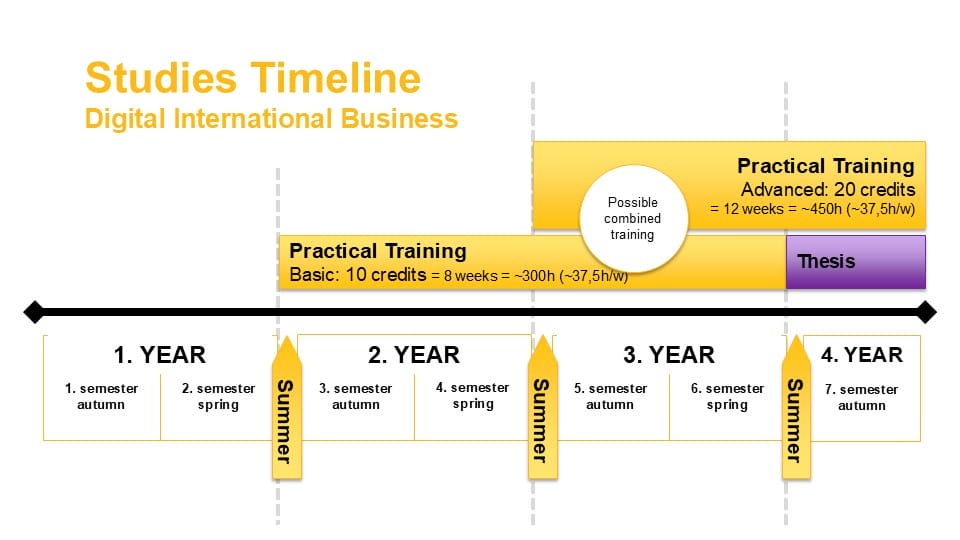
The language barrier is surprisingly low
The development of the work life path began by interviewing international students and asking about their experiences before coming to Finland and during their studies. These discussions were crystallized into one question: “What’s your story?”, what kind of decisions brought you to Kymenlaakso to study. Based on the data, the experiences were compiled into good and bad experiences, and this theme was explored in more depth in workshops, which discussed the students’ expectations and needs, focusing on internships. It was impossible to completely separate the practical training from the whole, which was formed by the person’s experiences in Finland.
The interviews and workshops provided a comprehensive picture of the international student’s mental landscape regarding studies, Kouvola and employment. Active students were looking for opportunities to show their skills and learn Finnish work culture, but studying the language was seen as challenging. Finnish is notoriously difficult, but the requirement for fluent language skills is also part of the employment conditions for international professionals. Language skills and their requirements emerged in the first discussions with both students and companies.
One of the most important pillars in designing the work life path was the students’ concern about learning the language, combined with the companies’ requirements for language skills. Understandably, customer service tasks in a local company require some language skills, but with technological solutions available to everyone, the language barrier is greatly reduced.
Discussions with companies about the intern’s tasks often started with the question of language. What tasks can an intern, who presumably only speaks a few words of Finnish, do? Who can guide them in English? Are the company’s onboarding materials, systems or coffee room chats available in English?
Concerns about dropping an individual international expert into a completely Finnish work community had to be considered when developing the path, but at the same time there was a noticeable enthusiasm for breaking away from everyday work. Coffee room discussions in the pilots were also smoothly translated into English when necessary, and the trainees were exposed to the Finnish language.
Sources
IDEO U. s.a. What is Design Thinking & Why Is It Beneficial? Blog article. Available: https://www.ideou.com/blogs/inspiration/what-is-design-thinking [Referred: 7.1.2025]
Designing the Work Life Path
The purpose of the work life path is to pave the way for recruiting international students in local companies. Since every student’s situation, skills and background, and the needs of the company are different, it is impossible to build a single model that works for everyone.
The following section presents four internship pilots carried out during the project and opens up their steps from the student and company perspectives.
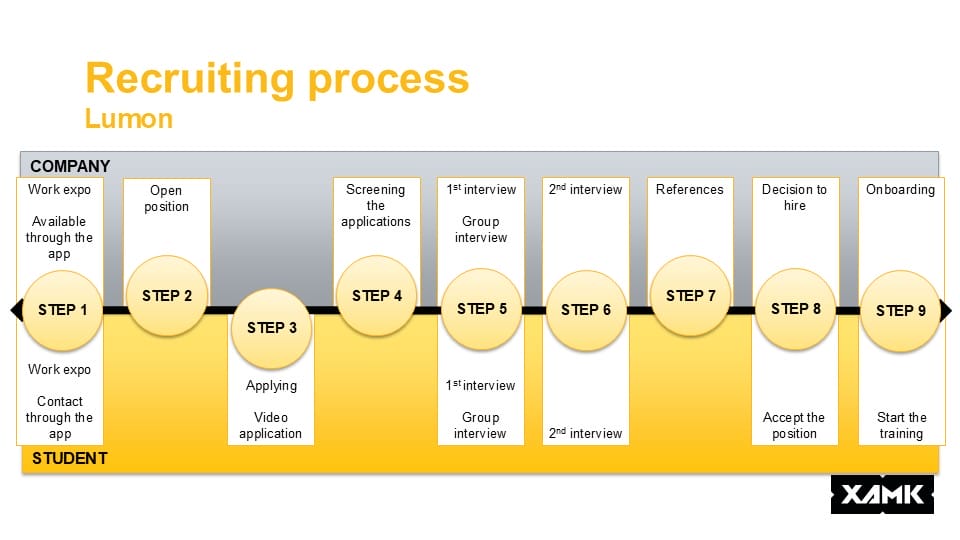
Lumon is an international group focused on the sale, manufacture, installation and maintenance of balcony facade and terrace products, and is a major player in the European and North American balcony and terrace markets.
Lumon’s work life path was strongly aligned with their recruitment process and the development focused on the first steps of the path: how a company representative meets international students and how Xamk can prepare them for an internship in a Finnish company.
Xamk organizes an annual Work Life Boom! fair, where employer representatives present their company on campus and students have the opportunity to get to know the companies and hear about jobs or possible internships for the coming summer. Lumon’s path began when the company’s Talent Acquisition Manager Saara Hirsto participated in the Work Life Boom on campus. She also participated in the Make it Happen seminar, where she presented Lumon’s operations to students interested in internships.
The recruitment process proceeded as follows: the international student responded to the job advertisement with a video application, followed by two rounds of interviews and checking the applicant’s references. On the Lumon path, the international student completed his advanced practical training at the company’s Kouvola office in financial administration tasks. After completing his thesis elsewhere, he was hired by Lumon.
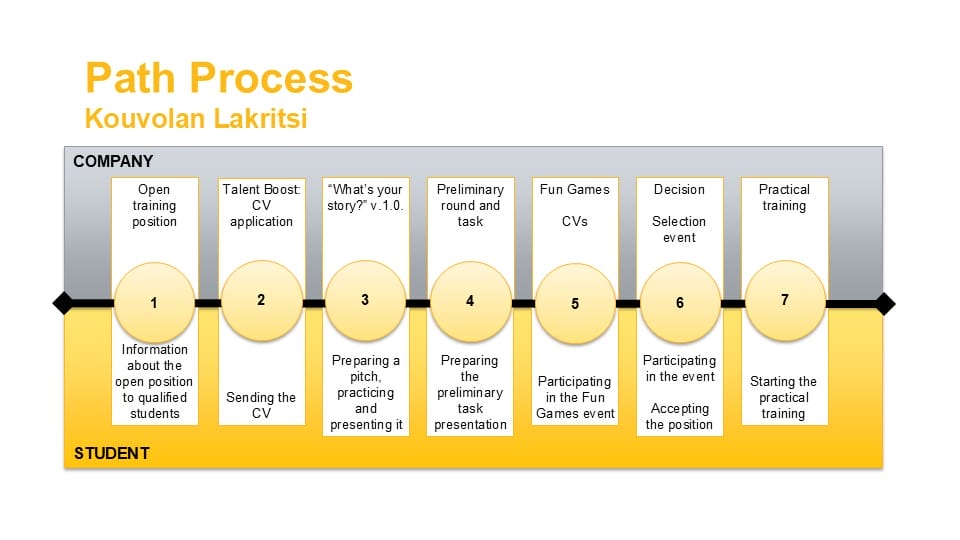
Kouvolan Lakritsi manufactures liquorice and other sweets in two locations in Kouvola, one of which also houses a factory store. The company with a long traditions joined the work life path pilot in the summer of 2024.
Kouvolan Lakritsi was looking for an international student as an intern through the Talent Boost program. The Talent Boost program is a cross-administrative international recruitment and work- and education-based immigration program coordinated by the Ministry of Employment and the Economy, and the Ministry of Education and Culture. The program aims to improve the opportunities and interest of international students to settle in and work in Finland after graduation.
The first round of the recruitment process was a CV application, which also checked the applicants’ eligibility. The paid internship also attracted interest from applicants who had already completed the practical training required as part of their degree.
As part of the recruitment process, What’s Your Story? event was organized, where applicants invited based on their CVs presented themselves and their skills in a one-minute speech. Before the event, the applicants had received instructions on how to prepare their presentation. Eezy’s Recruitment and Research Consultant Sanna Tukiainen was present at the event to provide feedback to the applicants.
A pre-qualification was conducted for the next stage of the recruitment process, based on which five applicants were invited to continue. They were given a preliminary task to plan the promotion of the company’s exports, for example to their own origin country.
The recruitment process culminated in a Fun Games event organized at the premises of Kouvolan Lakritsi, which replaced a traditional job interview. The idea of the recruitment event was that applicants could not prepare for it in advance, except for the preliminary task and their own one-minute presentation speech. Kouvolan Lakritsi CEO Santeri Nisula was involved in all tasks of the Fun Games event to monitor the applicants’ performance.
In addition to the preliminary task, there were three Fun Games tasks. In the first task, the applicants collected a 500-gram bag of liquorice – without a scale – without knowing that they would have to use the collected liquorice in a later task.
In the second task, each of them took on the role of a customer service representative at the factory store. The purpose was to simulate a working day in the store, where a new customer is always welcomed and offered a liquorice tasting. Unfortunately, the factory outlet was closed during the recruitment event, so the company’s artistic director Timo Nisula was invited to play the customer.
In the third task, the applicants had to use the contents of their liquorice bag and create an art installation and pitch a story in a few minutes to sell their work to the CEO. Each of the tasks was scored in a playful way and the applicants’ performance, attitude and dedication were assessed.
The participants in the Fun Games event were invited to campus the next day, where it was revealed who had been selected for an internship at Kouvola Liquorice. Each of the applicants also received feedback from the company and the reasons for their placement in the selection process.
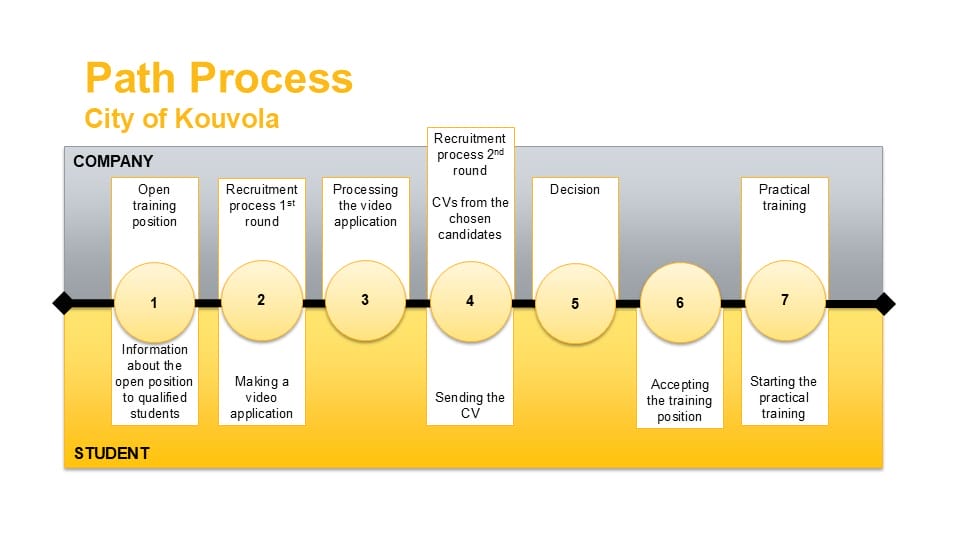
The City of Kouvola opened a work life path for two international students in need of a basic practical training job in the summer of 2024. The city organization is extensive, so initially it had to be considered for which city units it would be possible to even take on interns and what tasks they could do, assuming that the intern’s Finnish language skills were weak.
Suitable open positions were found for one intern in the city’s human resources services, Visit Kouvola and communications, and another position opened up in international services. The trainees’ tasks included compiling various reports, communication and marketing tasks and translating onboarding materials. This required identifying needs internally within the city.
The recruitment process began by communicating the open position to students through Xamk’s student coordinator Hugh Clack. Students applied for the open positions by sending a video application of approximately one minute in length, in which they told about themselves and their background with the idea of What’s Your Story? At the city’s request, applicants were instructed to emphasize their motivation for the positions and to present themselves in a relaxed manner.
The project received the video applications, after which the applicants’ eligibility was verified, i.e. they had to have a real need to complete the basic practical training credits. The video applications were forwarded to the city’s representatives, and they asked for CVs from the four best applicants, based on which they made choices about hiring two students. The City of Kouvola’s recruitment in the work life path was very agile and fast. Close cooperation was carried out with the education to find suitable applicants.
The work life path continued after the internship for Digital International Business student Adiluzzaman Dhrubo, when he began writing his thesis for the City of Kouvola’s human resources services.
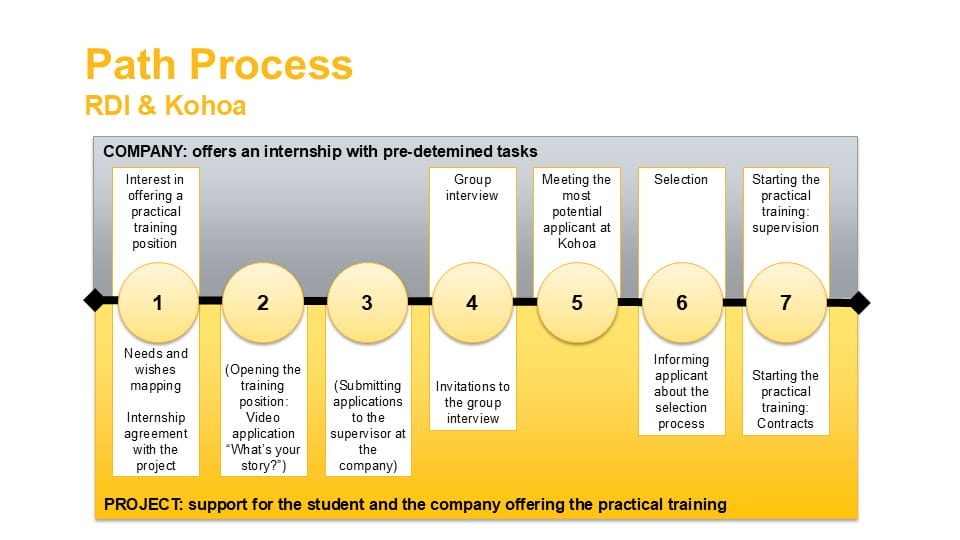
As part of the development of the work life path, it was considered how cooperation between local companies and Xamk could be developed so that projects, trainees and companies would be brought together. In accordance with Xamk’s strategy, research, development and innovation projects offer practical training opportunities for students, and previous projects have experimented with how trainees in projects could benefit the local business community in the lightest and easiest way possible from the company’s perspective. Based on these starting points, it was agreed that the trainee would officially work in the project, but her daily work tasks would come from Kohoa, even if she also participated in the development work of the project.
Kohoa is an entrepreneurship house located in the centre of Kouvola, with which Xamk collaborates and also acts as a tenant. Kohoa’s hope was to get international students to make more use of communal spaces, where they can, among other things, plan to start their own company.
A possible practical training path was considered with a Kohoa representative through their needs and wishes: what tasks could a student completing a basic training do? The training position was opened to students in need of basic practical training. Applicants submitted a video application in which they briefly told about themselves, their background and their motivation in a What’s Your Story? style. The Kohoa representative reviewed the video applications before a joint group interview, to which the six most suitable applicants had been invited.
After the group interview, the two most suitable applicants selected by Kohoa were instructed to contact their future supervisor of the workplace and arrange a meeting where they could get to know the Synergy Center and its activities and discuss their own development ideas to promote student cooperation.
Template for Designing Your Work Life Path
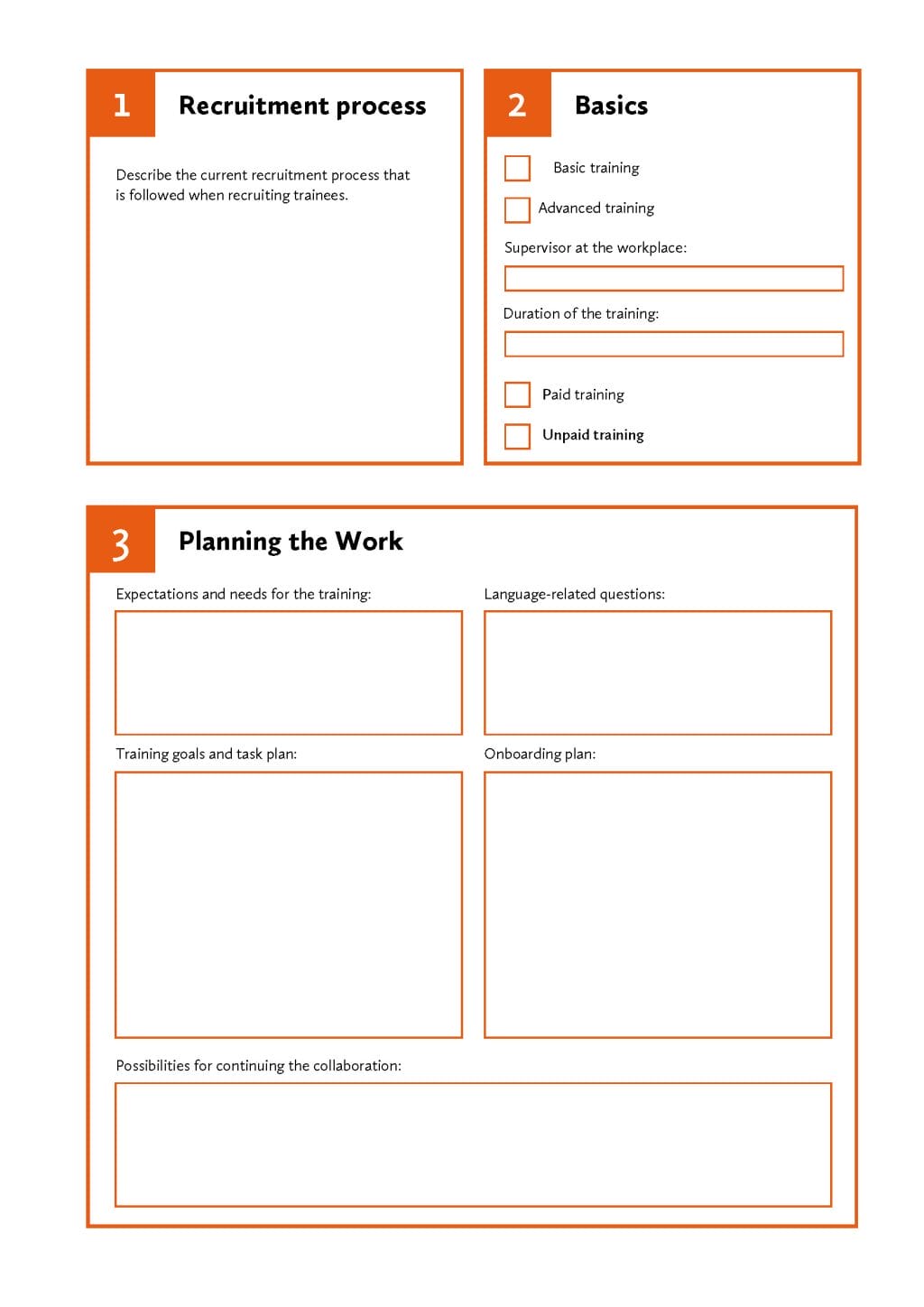
Instructions for Using the Template:
1. Recruitment process:
Describe the current recruitment process that is followed when recruiting interns. The basic training for a university of applied sciences degree is only a few months long, so it is a good idea to consider how much time and resources it is reasonable to spend on the trainee recruitment process. Is it possible to streamline the current process?
2. Basics:
- Basic or Advanced training? Basic training introduces the student to work life in their field and everyday work. Advanced training focused on developing field-related skills. It is worth noting that international students completing basic trainings may have very little or no work experience in Finland.
- Who supervises the trainee at the workplace? An international student’s supervisor is typically required to have a moderate level of English language skills and, of course, the courage to use it. Supervision is also a good opportunity to use language skills at work.
- Duration of the training? The basic training included in the degree is usually 10 credits, which means eight weeks of 37.5-hour work weeks, or a total of approximately 300 hours. The advanced training is 20 credits, which means 12 work weeks and approximately 450 hours. The weekly working hours and the duration of the training are agreed between the employer and the student.
- Is the training paid? Unlike Finnish university students, students from outside the EU pay tuition fees, which makes them more interested and motivated to look for paid internships. So, the issue of pay should not be ignored outright.
3. Planning the work:
- Expectations and needs for the training: What kind of tasks require, for example, background research, helping hands, or the perspective of an international student? What value is expected from the trainee? What is expected and wanted from the training?
- Language-related issues: What materials, systems, etc. relevant to the work are available in English? Can support be offered for learning Finnish? For example, can the trainee use working time to study the language?
- Training goals and task plan: The final goals of the training are agreed with the student, but what is the goal from the employer’s perspective? Which tasks are the trainee’s responsibility? What types of tasks do not require Finnish language skills? For example, are there various investigative and routine tasks or tasks based on the trainee’s special skills or previous experience? It is worth writing down ideas on the template while you familiarize yourself with the interviews in this handbook.
- Onboarding plan: Are onboarding materials available in English? During the orientation, it is worth considering that an international student may not be familiar with Finnish work culture. It is therefore worth investing in communication and familiarizing yourself with generally self-evident practices in our working culture.
- Possibilities for continuing collaboration: If it is a basic training, could the trainee also continue with an advanced training or receive a thesis topic from you? The possibility of ordering a thesis is worth keeping in mind, as it is a good way to continue meaningful collaboration.
Work Life Path Experiences
Each of the work life path training pilots had a slightly different emphasis during the summer of 2024, both in terms of the recruitment process and the training tasks themselves. All trainees completed the trainings as part of their studies, so they could not be required to perform tasks requiring special skills – unless they had work experience in another field before their studies.
Many areas for development and things to try out were found in the steps of the work life path for the following pilots with the companies.
Company Representative Interviews
Saara Hirsto was a representative of Lumon Group in the first training pilot of the Work Life Path. Her role as Talent Acquisition Manager includes supporting the entire global organization in matters related to recruitment and employer brand.
Tell us about your experience with Work Life Path.
The path progressed in a way on its own weight. The collaboration began in the spring of 2023, when kick-off meetings were held with the project and a visit was made to Ponsse. The beginning was quite intensive and overall, the whole thing was good. For us, the result was one recruitment, and we hope that through these experiences we can utilize the path and international experts more in the future. Finding and recruiting the expert was a great thing. He is a really good employee for us, and it is great that we were able to make him a permanent employee. Hopefully, we will find more gems like this in the future.
What kind of challenges did you face in recruiting the international expert?
There were no real challenges. Of course, the fact that the world situation was uncertain for a while and it was not known whether an international expert could be hired after the internship. In an ideal situation, the path would have continued smoothly from the training, and he would have stayed in the company, after which he would have been made a permanent employee. However, there was an unfortunate break in between.
If you think about the recruitment process, it went well, and we followed the standard process. We had two interviews with the applicant. The first was with me remotely and then we had a face-to-face meeting, in which the supervisor was involved. I also called the applicant’s former supervisor about the references, and he got really good feedback. So, the recruitment proceeded quite typically, how we recruit summer employees or trainees.
After the internship, he was away for a while and did his thesis, after which he was hired on a fixed-term basis. When he was hired for his current role as Financial Development Specialist, a third interview was held with the head of our sustainability project. The sustainability perspective was reflected in it, as the role was related to it.
What changed in your company after recruiting the international expert?
I haven’t lived the everyday life in the finance team where he works, but we have been really satisfied, and he has received good feedback. He handles the tasks well and he has good experience and competence for the role. The finance team has received him well and he is a really well-liked employee and a wonderful person.
What is significant is that he brings more competence to our own finance team as well, especially in terms of language skills. They will be able to, or must, use English at work, which they have not been used to until now. So, this is a challenge for the organization at the same time.
What has your company done to promote the recruitment of international experts?
When I’ve opened recruitment, especially in the Kouvola region, we’ve always had a discussion, and I’ve asked what if the person being recruited only spoke English. In other words, in a way, we have opened up and perhaps prepared our superiors for the future, so that they would also think about this perspective. It doesn’t necessarily occur to us that the person being recruited could be an international expert. However, we have tasks where we serve the entire global organization. Of course, the closest colleagues are Finnish-speaking, but if an international expert recruited through the path has succeeded in this, why wouldn’t it be successful for someone else?
I try to create a positive attitude and atmosphere here, so that recruiting international experts could be more possible in the future. One key factor in this pilot was that our CFO is used to speaking English and has strong language skills. That helped this recruitment. When I asked her what if the recruit wasn’t Finnish, she replied that of course, no problem. I would like to see more of that from our side, but it still takes some time.
What could be done better to promote the recruitment of international experts?
This is an interesting question, and I have pondered it myself when I visited Xamk at the Work Life Boom fair and met these international students. There are so many of them. I have to say that this challenge seems a bit desperate. I don’t understand how everyone can be employed.
Maybe companies should think about this more. What are our needs in the future, what specific skills the jobs require and thereby modify the education programs that these people will study. It seems that there are a lot of international business students, and it is a field that is difficult to apply or find a suitable position for them. I would like to see more concrete and specific information about it.
Ninni Kurko-Seppänen supervised an international trainee in the human resources department of the City of Kouvola in the summer of 2024. As a human resources planner, her job description includes tasks related to developing the organization’s competence, such as coordinating internal training and developing supervisor work and leadership, as well as matters related to orientation and recruitment.
Tell us about your experience with Work Life Path.
Overall, the experience was very good. The project provided excellent support, and we gained just the right skills and the right people for our units. The cooperation with Xamk was pleasant and smooth. The project allowed us to flexibly adapt our international trainee recruitment process and student selection to suit our needs. We were really satisfied with the training experience itself and gained excellent skills for our unit.
What kind of challenges did you face in recruiting the international expert?
One challenge was that the city has had very few international trainees. However, through the training process, we were able to clarify and increase awareness of the expertise and benefits that international experts bring to our organization. And increase the number of international trainees for the following year.
On a practical level, challenges arose in particular from the fact that most of our instructions and materials are only available in Finnish. This required us to take a new approach and consider things differently than with Finnish-speaking trainees.
What changed in your company after recruiting the international expert?
We made the internal process for the future. We have now established the created process and model so that we can continue to attract international trainees to our organization.
What has your company done to promote the recruitment of international experts?
We have created a process for internships, made guidelines, and communicated the importance and opportunities of international trainees.
What could be done better to promote the recruitment of international experts?
The key still is to raise awareness and effective marketing. It is important to clearly communicate what recruiting international talent means in practice, how your organization can benefit from an international trainee, and what opportunities you can offer trainees.
We need a clear and consistent process for what accepting trainees into units and the organization means in practice. This will help streamline operations and lower the threshold for taking on international trainees.
It would also be very useful if the project or university could provide marketing-friendly material. Xamk offers education in many different fields, so it would be important that presentations of different fields are easy to find. At the same time, it should be made visible which kind of trainings in these fields are particularly sought after.
Kaisa Spies participated in the Work Life Path as a supervisor of a trainee at MOONA (Immigrant Guidance and Counselling). She is responsible for the international services of the City of Kouvola, i.e. support for settling in the city for different immigrant groups, including international students. MOONA offers integration guidance and service counselling to its clients, among other things. Kaisa’s job description also includes developing services and network cooperation in addition to acting as a supervisor.
Tell us about your experience with Work Life Path.
The experience was good. The biggest benefit of the project was that it pushed us forward. We basically had the same idea that it was important for international students to have access to internships and find pathways into working life. In that situation, when the student was practically accepted for an internship, the project helped to translate words into action.
What kind of challenges did you face in recruiting the international expert?
The biggest challenge was money. Since the city’s finances are tight, finding the salary money was almost a deal breaker. Even though the training compensation is small, recruitment almost failed because of this. For the new budget period, I have been able to take this into account so that we have made a provision in the budget. I think that from the city’s perspective, each unit should make a provision in its budget for the training of one international student, so that they can be hired in the future. This would be a good starting point.
Recruitment and starting the training would also have been easier if we had onboarding materials and, for example, an employment contract template in English, i.e. the basic bureaucracy package in order. This would further lower the threshold for taking on a trainee.
I know that many people wonder whether a trainee will adapt to the work community and how the work community will react, but I think that a two-month internship is a really short period of time, so it’s worth it. The challenge is the same with any new employee.
What changed in your company after recruiting the international expert?
The threshold for taking on an international student for a training is lower. We had a really good trainee who dug up information and got to know things independently. These first trainees have a lot of responsibility in that they also represent future trainees. The next trainee may require a lot of help and advice or do their job worse, so the responsibility is unfair in terms of what kind of image the employer creates. Since this was a really nice trainee, I think I can take on three of them next time.
What has your company done to promote the recruitment of international experts?
We have been thinking about city-level policies and guidelines with the city’s human resources services. Our intranet has compiled basic information about what it means to take on an international trainee. For example, there is contact information there to make the process as easy as possible if a city unit comes up with the idea of taking on a trainee. You can find information on how to proceed and a path that guides you by searching the intranet.
I noticed that many units had difficulty understanding what a trainee could do, because they do not have activities related to the digital international business title. I also told the project that it would be a good idea to describe in more detail that job descriptions can be very loosely related to development or benchmarking. We then tried to articulate these to others.
It also emerged that it is possible to apply for support for the salary costs of an international trainee, and this clearly lowered the threshold for many city units. I noticed that units could be encouraged to apply for funding by being in personal contact and telling them about the possibilities and brainstorming work tasks together with them. However, expanding this thinking within the organization requires a lot of personal contacts.
What could be done better to promote the recruitment of international experts?
Exposure to these international trainees and the idea of recruiting them should happen in small steps. When I was brainstorming the training’s content, I noticed that many people were interested in taking on trainees, but they were worried that they would not have work assignments to give for two months.
It would be easier if a unit like MOONA, which is a little more flexible about this, could take on trainees and then lend the trainee’s work to different units as needed. This could be a convenient way to expand the training model. I think that it could also be good for the trainee, because they would get a wide range of contacts and insight into the city’s operations if they work for a couple of weeks in the sports services and a couple of weeks in the green team or Kinno. Then the unit and the supervisor would not immediately be responsible for the entire two months.
Santeri Nisula was involved in shaping the work life path for Kouvolan Lakritsi. As CEO, his field of work is broad, and he is responsible for the entire company’s operations. His duties also include operational development, sales and marketing, and product development.
Tell us about your experience with Work Life Path.
The experience was good, and actually really interesting and positively different from what we have usually done. It was fun that the project had come up with a slightly different approach to recruitment. It gave a really clear picture of the character of the applicants. This was good because afterwards there was a picture of what kind of roles each applicant is capable of, without even looking at anyone’s skills. I actually had no background information about the applicants’ skills. We hired based on the person itself and their attitude. And the experience turned out to be good.
What kind of challenges did you face in recruiting the international expert?
One of the biggest challenges is with Finnish language skills. Most of our customers are still Finnish and we need to be able to serve in Finnish. This limits our ability to offer job opportunities to foreign job seekers.
We do not have any actual back-end tasks that could be filled by international experts. It is possible in production, but in roles where you spend a lot of time with customers, language skills are needed. The same applies in other markets, for example, in Sweden, Swedish language skills are needed and in Spain, Spanish language skills are needed. It is not just about Finland, but in those markets, language skills are always needed. If you do not have language skills in Finland, it is challenging. We do not have any roles that you could get into without language skills, except in production.
What changed in your company after recruiting the international expert?
We have always had international employees, so nothing has changed in that sense. However, we saw that this experience of recruiting and training an international trainee was also a success.
What has your company done to promote the recruitment of international experts?
We have not had any open recruitments before the current position requiring Swedish language skills. Anyone can of course apply. We recruit people according to the need and if an international expert fits the role, then of course they will be recruited. Everyone is welcome to join us.
What could be done better to promote the recruitment of international experts?
After this international student’s training, I heard how challenging it has been for them to find internships. Yes, there are clearly strong prejudices behind it, when companies are not even prepared to give them the opportunity to get an interview.
Creating an international work environment, if there hasn’t been one before, would be the first thing. Of course, there are challenges in that too, when, for example, the working language is suddenly changed, because if even one employee comes in who doesn’t speak Finnish, then everyone has to start using English as the working language with this person. Help is needed to create such a work environment so that the so-called start-up cost would not be so challenging. Perhaps this could be promoted, and certainly awareness of the possibilities and experiences.
I have seen a lot of working life in the Helsinki region, and it is completely normal there that the working language is English. There are also a lot of these international employees abroad, and there is nothing new or impossible about that, but perhaps there hasn’t been that much recruitment of international experts here yet. In any case, it is a difficult question.
Xamk Representative Interviews
What is your role at Xamk and how does it relate to increasing internship opportunities for international students locally?
As the Director of Education, I am responsible for the education of business, culture, catering, community pedagogy and joint studies. The majority of these educations have international students.
For my part, I strive to influence companies, communities and municipal actors so that they take into account that we need these international experts and students and internships for them. In other words, from my own position as a member of the executive team, I also strive to influence these actors who could take on trainees.
What is the significance of university-level internships for Kymenlaakso?
If we assume that Kymenlaakso as a whole is a migration loss area and the age groups are getting older. We do not have a young generation in our local or own area that can then respond to possible future challenges of new jobs. According to forecasts, we will have more labour needs than supply. Then we need labour-related immigration.
The other side is that we get our students to stay and adhere to the area. That way we would get a skilled workforce for business life. However, we train people at the level of a university of applied sciences who have strong competence in their area of expertise, so they have potential as a workforce.
What things do you think should be changed or developed to improve the employment opportunities of international students?
I would say that there are three different segments in this matter: The most difficult part of all is that the welcoming atmosphere in our areas of operation in Kymenlaakso and South Savo is not the best possible. I mean individual residents, individual people who are not very inclined to accept new people. I have seen this in many contexts, that regional attitude education is needed.
On the other hand, there is a skills gap in the ability and possibilities of companies to carry out international recruitments. In a way, they do not dare to do so, because they do not have previous experience in recruiting international students or other skilled people in general who are not native Finns.
Regarding international politics, our current situation is unfavourable. It affects the arrival of international experts here and especially their staying in the area and recruitment.
What is currently preventing the development of these things?
This discussion about language policy has been going on a lot. In the Kymenlaakso region, the Finnish language is so strongly represented in working life and companies are not prepared to take on English-speaking staff. That is quite understandable, especially in service sectors where there is customer contact. Customers also want Finnish-language service.
One thing is of course that when students do not get internships or temporary jobs, it is difficult for them to stay and commit to the region. They easily move to the Uusimaa region to do odd jobs. They then do their studies from there and thus do not end up in our region’s job reserve.
How do you see Xamk’s role in this?
We are a significant university in the region, so our role is of course to produce new expertise and new experts. That is our basic starting point in terms of regional development. On the other hand, our role is also to grow and offer expertise to companies so that they can utilize international expertise. We bring international expertise here and grow companies to utilize it through research, development and innovation.
On the other hand, attitude education is also part of Xamk’s role. If we think about community educators or people who do youth work, it is also our responsibility to bring that international atmosphere, acceptance and cultural pluralism to the fore in everything we do. So bringing out themes of tolerance is important.
What are the three most important development areas from the perspective of Kymenlaakso?
Firstly, the development of a common will and the operating environment of public institutions working with international experts − whether they are ELY Centres, development companies or integration services organised by the city. This work is currently being done, but as a path, how to integrate international experts into actors and work tasks in our region, as well as the integration process, are important development targets. This work should now be started more vigorously, because we have too many organisations that do good things, but there is overlap and their own roles are not recognised.
It is also important for Xamk to be able to organise internships for students. In Kymenlaakso in particular, we have several hundred business contacts, so using them to support international students is important.
Thirdly, the development of language studies, i.e. Finnish language studies. In order to integrate international students and experts, Finnish language and cultural competence and understanding are important. This is a joint task with regional actors, but of course especially for us at the university. As responsible educators, our task is to offer these students, together with other actors, a path to integration into the region and, for example, to getting a job or arranging childcare.
What is your role at Xamk and how does it relate to increasing internship opportunities for international students locally?
My main role is a senior lecturer, then I’m also the practical training coordinator. On top of that, I have resources for our Talent Boost project every year. So mainly to help students find their training places, not to find them for them, but to help them find them themselves and to ensure that the training is suitable for digital international business, both basic and advanced training.
What is the significance of university-level internships for Kymenlaakso?
I think it’s really important. One of the main aims of the programmes taught in English is to increase the number of foreign students here so that they become employees in the future. And one of the main ways to get employees, especially from abroad, is to have them do their training here in Kymenlaakso. If they have done their training, both basic and advanced for a company here, they’re more likely to write their thesis for that company and then be employed by that company in the end.
What things do you think should be changed or developed to improve the employment opportunities of international students?
We’re doing everything we can as a university so there is not much more we can do. Students come here from, for example, Nepal, India, Pakistan or Bangladesh, and they often have bachelor’s degrees already, some even have master’s degrees, and yet they still come here to study. Even these students can’t get jobs when they come to Finland.
Maybe it’s the lack of trust with employers in the area for employing foreigners or it comes simply down to lack of communication skills. Because these students would be coming with English as their native language or as a second language, and then employers might not be ready for that. I think outside of Kymenlaakso the situation is a little bit easier for employers to find students with English skills and to employ them. But here it seems to be a bit more challenging.
So, I think the attitudes of the employers need to change. This could be changed by employers taking students first for practical training, then realising that the students can do the job, and the employers will manage with English.
What is currently preventing the development of these things?
Simply put I think that the employers might not be willing to take the risk of recruiting an international student. The employers and students should get to meet each other, so the employers can see that it’s not such a big step to take on these non-Finnish speaking students. But, of course, Finnish language could help.
Students who are just arriving in Finland have three or four hours a week of Finnish lessons and it is not enough to learn the language. I’ve still been doing it after 30 years. If the students are employed, they will pick up the language a lot easier in the workplace than they will in the classroom. So that’s one thing that employees could be looking at.
One negative point is that many students don’t appreciate the training, because it is usually unpaid. They’re not motivated to do it. Especially when you factor in the fact that they’re paying so much money for their tuition fees every year.
Sometimes for that money the students expect that they would be given a training place, and they don’t have to look for one. Also, that it would be paid training place, so they’re getting some money back.
It’s not common to find a paid training place so what happens is that students are looking to Helsinki, finding jobs in restaurants, for example. They’re getting paid for those part time jobs. And that is more important to them than a training place, because if the training is not paid, they’d rather work part time. Then they also lose their studies because of that work and the lure of payment.
Even though we see it as a part time job, for them it’s a big deal because the pay is so much more than what they would get in their own countries. So, it’s more lucrative for them to do that and then they don’t really think about the future. They’re thinking short term, not long term. It’s a common thing in in all over the world for students. But how do we overcome that? One way is to find paid training places, that students would really appreciate then. And as I said, they would be more motivated and do a much better job.
How do you see Xamk’s role in this?
Xamk should be engaging with companies a lot more and getting students together with companies. Firstly, convincing companies that they should be looking to our students for the future. We have a lot of students here and the number of foreign students is increasing all the time. At the moment, just in the digital international business programme, we have about one-hundred full time students per year. They will be here for 3,5 years. We have exchange students coming here as well. When we add in other degree programmes, we have a vast number of foreign students including the master’s and the Diploma programmes. It’s a big pool of employees that employers could take advantage of.
Something that we have been doing now with Talent Boost is reaching out to companies and asking if they are prepared to take on students. We would pay the salary through the funding. The employers have responded tentatively to this so far, but this year is better than last year. Hopefully next year is even better.
We are trying to make it easier for the employers by choosing the students ourselves. So that they don’t have to go through all the CVs and possibly the difference in cultural attitudes in the way students apply for the jobs. The students apply to us, then we tell the employer which student they’re going to get. We must base it on our knowledge of the student and the information they provide so we can find them the suitable position, or for the employer the suitable student.
All the companies have to do is to let the student come and work for them. They get motivated students because the student is getting paid, and the employers don’t have to worry about the application process. When the student is working for them, the employers can see that this is something they can do in the future.
What are the three most important development areas from the perspective of Kymenlaakso?
For the eventual jobs, it’s making that connection with companies beforehand so that companies can see graduates from University of Applied science as efficient employees.
I think from the training’s perspective, what my vision many years ago was that companies would already make agreements with us, and they would take a certain number of trainees each year, even if it’s one or two trainees. And we could also use it in our marketing activities that we can promise students a job.
In many of our European partners in France and in Germany, for example, students know as soon as they start the programme that they have a job in a particular company. The universities are working very closely with those companies, and this is what I would see here because everyone would benefit. Companies could have much easier recruitment strategy when they know they’re going to get two students per year.
Those students will probably be the future employees. Rather than, hey, we need employees next year, where are we going to find them? Let’s start a recruitment campaign. I think this closer cooperation is certainly a development area that we could look at. We could already be working with the companies for their future employment strategies for both trainees and future employees.
I think also looking at the kind of work that students would be doing for those companies and aligning our education with that. We have tried to do it in the past with many companies. It doesn’t always work. You know it’s something that we must look at both from company perspective and building the curriculums, but also attracting students to come and study here. We try to do this as much as possible, of course, keeping up with the latest technology and trends in education.
This is also something the company should be looking at here, that things can change. Many companies are very traditional. And they think that okay, this is the way we’ve always done it, and it works. So, let’s carry on. Well, things could change, and this is also another reason why they should be thinking about students, because students have the latest information, and the latest skill set that could be of benefit to the companies.
What is your role at Xamk and how does it relate to increasing internship opportunities for international students locally?
I am a Research Group Manager and lead the Digital Business research group from the Mikkeli campus. We have just under 30 experts, and we work on a wide range of multidisciplinary and interdisciplinary projects. The common denominator in the projects is a strong business interface and the development of companies’ business according to rising themes and topics.
My work is connected to increasing internship opportunities for international students in that I prepare a lot of projects with companies. I know about their needs and that it is difficult for them to find experts. Similarly, we collaborate in our projects with business administration and IT education. Of course, other students are also involved in the projects. Through this cooperation, there is a connection to promoting employment opportunities for international students.
What is the significance of university-level internships for Kymenlaakso and South Savo?
In both Kymenlaakso and South Savo, I personally see the importance of internships as a great way to get international students and our students in general to take root in the region. The distance and online education that has become more common due to the Covid pandemic has posed a great challenge in recent years, which means that students do not necessarily move to localities.
Especially for international students, because they do not have knowledge of Finnish culture and working life, they also do not have knowledge of the local business and working life world. This is a major challenge that has been jointly identified by various actors.
What things do you think should be changed or developed to improve the employment opportunities of international students?
Surely this already starts from the educational programs and their contents. How do they take into account the perspective of international students. What should they be taught and how should they be trained in a way so that they are ready to take part in Finnish working life. Through that, integration into our society in general would be possible.
Correspondingly, how could Xamk, in its own role, bring awareness and expertise to the business field about what kind of experts we study and graduate, and what potential they have, for example, to promote companies’ international business. Or in general, bring new expertise to the region.
What is currently preventing the development of these things?
This is perhaps a theme where the work is a bit fragmented and spotty. Each actor has their own interests. Xamk’s interest is to get students to graduate on time. When they have graduated, if we think of Finnish students, we assume that they will then manage on their own and move into working life. But with international students, there are different questions: will they stay in the locality, or will they stay in Finland at all?
On the other hand, how could we encourage small companies in particular to even try employing international experts, for example through internships or lighter project work? These are big questions.
In other words, the fragmentation of operations and the transition phase from student to employee. So many actors have some kind of role in these, but no one has the overall responsibility, or the resources specifically allocated to it. There are challenges to tackle here.
How do you see Xamk’s role in this?
We have strong RDI activities and are a major education provider. The number of international students will certainly increase overall both in Kymenlaakso and in South Savo at Xamk. We can help with a different kind of development work that unites all these actors, as has already been done in part in the Work Life Path project. Acquiring resources to support this joint development is at least one area in which we can provide support.
What are the three most important development areas from the perspective of Kymenlaakso?
The first is to identify and acknowledge the potential of international students in our region, and their presence and its significance for the vitality of the region, business life and companies.
On the other hand, once we have identified this common challenge and problem, we should find a common will and direction to take. These challenges certainly cannot be solved all at once, as has become clear over the years.
Third, to look for different ways and means to find the necessary resources to support international students in their transition to working life. Correspondingly, how could we support companies so that they are more prepared to accept international students.
Music has been a central part of my integration into Finnish culture since my early years. Together with the St. Petersburg accordion orchestra, we regularly performed at international music competitions across Europe, including festivals in Ikaalinen and Tampere.
After completing my music education, I started studying at the best university of economics and finance in Russia at the time, UNECON. Before completing my bachelor’s degree, I had the opportunity to come to the University of Jyväskylä for the winter semester on a bilateral FIRST exchange, when a student from Jyväskylä was on exchange in St. Petersburg. At the University of Jyväskylä, I chose several courses on family entrepreneurship, intrapreneurship and leadership, because at that time I was working with my parents in a family business in St. Petersburg specializing in artistic forging and restoration.
Gradually, I managed to learn Finnish through language courses at the university, through various hobbies where I did not have the opportunity to speak my native language, and also through research. For example, during my research work in the Historical Economic Archives, it was possible to better understand the development of Finnish business culture. Music lessons, participation in Orthodox church life, and active volleyball practices strengthened my communication skills and made new acquaintances in the EU and Finland.
I did quite well in my studies and made the first drafts of a scientific research at the Jyväskylä University School of Business and Economics. I was first invited to the master’s program and then to doctoral studies, where I also had the opportunity to work as a doctoral researcher. In Jyväskylä, I got my first experience of independent teaching and developing research projects, and I became interested in applied work under the leadership of the world-famous professor Matti Koiranen. However, for various reasons, the family business unit in Jyväskylä was closed and the direction of scientific research changed completely.
However, I wanted to further develop my teaching and project skills after my PhD. After a little searching, I found such an opportunity at Mikkeli University of Applied Sciences. Later, Mikkeli (Mamk) and Kymenlaakso (Kyamk) universities of applied sciences merged to form the current Xamk.
While working as a teacher in Mikkeli, I had the opportunity to acquire international pedagogical training at Jyväskylä University of Applied Sciences, where we worked in English together with, among others, engineers, entrepreneurs, airline captains, police officers and representatives of various professions. Thus, pedagogy connects people and helps to hone professional skills.
The path of a teacher is usually difficult and requires constant development. In my current job as an RDI Principal Lecturer and RDI Specialist, I particularly enjoy the multi-faceted work, where I have the opportunity not only to teach the same courses, but also to work actively in applied projects, write new projects, act as a mentor and facilitator for entrepreneurial teams, develop intercultural skills and make Finland more international and successful in the educational arena.
Student Interviews
Tell us about your experience in finding a practical training place.
In my current practical training, I am working with the Kouvolan Lakritsi App Project, or KLAP for short. In this project, we are gamifying the tour for their factory. We started with a small team of four people, which has now grown to nine and we’re looking to expand to 13 soon. We are creating both physical games for their game room and the app itself. With the app, users can walk around and explore the factory tour through gaming.
I did my first practical training through Xamk Game Studios. For that one, I just had to apply, pass the interview, and get in. So, in a sense, it was very easy. That was the basic training with the requirement of 150 working hours. This advanced training, being 650 hours, is a bit harder to find since you must have something that will be published.
I guess I was a bit lucky too, knowing the people working on the Work Life Path project, and them telling me about this opportunity. Of course, I still had to make it happen. So, it was more about recognising an opportunity that I saw in front of me and choosing to latch onto it. Then I contacted the people that I knew, and trust, and together we built the project based on our own experience and personal motivations.
What kind of positive, neutral, and negative experiences do you have with practical training in local and/or national/capital area?
The positive side is getting to experience a real work-life scenario, which is always valuable. I’ve worked before, but not in the gaming industry, so this project has been a really good way for me to get familiar with it.
The negative side usually involves small disputes within teams or frustrating miscommunications, sometimes even with the client. However, such issues can usually be resolved fairly easily through open and clear communication, and by being thorough during meetings. Overall, I have had more positive than negative experiences.
What did you learn during this process?
Personally, I have focused mostly on the business aspect, and I’ve learned a lot because of it. In both of my practical training teams, I have been the only one interested in the business side − which, luckily for me, means I get to do all of it. Of course, it can be an overwhelming amount of work. Am I tired? A bit, yes. But I am learning so much, and that has been very fun. Though we are getting some help with the business side of things soon, so I don’t drown.
What are your thoughts on studying Finnish?
As a Swedish-speaking Finn, I don’t appreciate Finnish as much as I probably should. I feel like my attitude towards Finnish is similar to how some Finnish people feel about Swedish. It often boils down to not having the best teachers and thinking that I don’t need it.
Finnish is also a really difficult language to learn. Right now, my biggest motivation to learn it is for work. I’m also studying game design, so most of my friends speak English, and the industry is international. Because of that, I haven’t really felt the need to learn Finnish. Still, it is definitely easier to find work if I know Finnish, but it does feel like an uphill battle to study and learn it.
What are your professional plans and expectations after graduating?
I want to become a producer or a project lead, which is what I’ve focused most of my practical training on. I’m applying to different areas within gaming and virtual production to see if I can land an internship or even a practical training position, even though I no longer need it for my degree. Hopefully, I’ll find a place where the position could turn into a job after graduation.
I plan on staying in Finland, at least for now. I am not opposed to moving, I’m a traveller at heart, and I’ve wandered to many places before this. But it would be nice to stay here for the time being and build a home base. This is where my family and friends are. Still, I know I can go anywhere, and I can find a way to feel at home.
Tell us about yourself.
I’m Enrico, 42 years old, originally from Germany but I’ve lived in Finland for a bit over four years now. In 2023 I decided to study again here at Xamk. Previously in Germany, I was working mostly in customer care service as trainer, coach, and team leader in process, development and quality management. Years ago, I studied Arabian culture and history of arts. Next to my studies I’ve been working as a clearer for almost four years now. So, I have established at least somehow a normal life here in Finland.
Tell us about your experience in finding a practical training place as a European citizen in Finland.
I think Finnish companies don’t really make a big difference between Europeans and non-Europeans. It’s more about Finnish and non-Finnish people. It’s not necessarily easy to find something proper as a practical training, but on the other hand, I also have to admit that even my Finnish friends have not had so much success in the beginning in trying to find a practical training place.
I think many companies don’t really know what they should do with a trainee, because a lot of companies are quite small and they see a necessity in having these trainees. It takes a lot of patience and resilience, to be honest, to find something and sometimes you really need to ask for responses. If you don’t get any, you have to able to be stubborn as well.
I did my basic training for the city of Kouvola, at the immigration integration services MOONA, which is located in Kouvola, Kohoa Synergiakeskus. It was more or less organized with the help of the RDI team (research, development and innovation projects) and Riku Happonen from Xamk.
I think I have sent around 20-30 applications in general for particular training places in different positions, different cities around Finland. I got maybe five responses, which were negative. Otherwise, there was no response at all.
When you wanted to apply for the Kouvola city training place, you had to make a short video, about 1,5-2 minutes long where we presented ourselves. It was under the motto “tell me your story”, meaning that we were talking a little bit about our experience coming to Finland and doing the things we are doing here as immigrants or foreigners.
The coordinator for immigration and integration, Kaisa Spies, chose me then, because she said she liked my attitude and also the experience I already had. Luckily, I was able to already speak Finnish, so they were quite surprised when I started there. We were talking in Finnish with the people working there, so it was quite nice welcome.
What kind of positive, neutral, and negative experiences do you have with practical training?
Throughout the entire process from the application, doing my tasks and everything else, I would say it’s more on the positive side. I don’t really have anything negative to say. Maybe sometimes I’ve felt a little bit bored because my tasks were a little underwhelming, to be honest. But on the other hand, I had the chance to do what I thought I would like to do or whatever I thought would bring the best the outcome.
I had a conversation with my boss there and she gave me a list of tasks they wanted me to do. We were going through all those tasks, and I said that a survey like this has already been done fifty times and the results are always the same, so do you think it is really necessary to do this? So, I had really good opportunities to bring my own input and also develop my own ideas. With a bit of communication it worked quite well. That is definitely a very positive thing.
Neutral things, I don’t know. There was nothing really negative. The work times were perfect. The people I was working with were really friendly and welcoming. I never had a feeling like, oh you’re a foreigner. You’re not a Finn. It was like a small family. I can say nothing negative about my training there.
What are your thoughts on studying and using Finnish as a working language?
Before I started my bachelor’s studies here, I visited an evening school to learn Finnish. So I had my skills before the studies.
At the practical training, the working language was 50-50 English and Finnish. Because for some of the workers it was just easier and more natural. Also, it was good practice for me to speak more Finnish than English. When there were more official things or something requiring a specific term, I switched automatically to English because the Finnish vocabulary just didn’t give me what I needed.
We also had a team meeting day, which was hyvinvointipäivä, a well-being day. Our team went to Tykkimäki Resort and for the entire day I spoke Finnish. All the activities were in Finnish, and it worked very well. Even now when I go to Kohoa for lunch and see the people, we talk in Finnish.
What are your professional plans and expectations after graduating?
The thing is, what I exactly want to do? I’m not sure yet. My field of interest is quite big and I would like to see what companies have to offer. I know that I don’t want to become an entrepreneur myself. I think I would like to go into the direction like HR, or I like marketing as well, but it is a hard field because the competition is high. I was a trainer and a coach in communications so I would love to do something like that again. Let’s see what I can find. I definitely love to work with people.
In November, I have five years full so I can apply for Finnish citizenship. I don’t want to go back to Germany. In case I want to apply for citizenship, I want to keep double citizenship just to keep my options open. I usually have plan B, C and D, but in general I’m open to stay in Finland. After giving up everything in Germany, I don’t want to restart again. I feel quite comfortable here and I can understand the struggles that especially international students or people coming from outside Finland or EU have.
The work situation in Finland is difficult, but I think it works a little bit different than in the rest of the world. Somehow, they have a different logic. I found my job and I’m working for that company already almost four years. So, it must have worked out somehow, but that could also just be luck. Big point is learning the language. The language courses at the university are not sufficient.
What’s your story?
I’m Adiluzzaman Dhrubo from Bangladesh and currently studying a bachelor’s degree in business administration. My major is international business and I’m doing my studies at Xamk’s Kouvola campus, but I live in Helsinki.
First, I went to Denmark to pursue my higher studies in marketing and management. There I completed around 80 % of my studies. It was an academic professional degree, or in Finland it’s called a diploma degree. Then, I transferred my credits to Finland and didn’t end up finishing the diploma in Denmark. I thought that it’s a better option to do a bachelor’s degree.
So, I talked to the university here and they said that it’s fine, I could transfer my credits and get admitted to Xamk. I came to Finland and started my studies in September 2023. At this moment, I’m almost at my last semester and I’m writing my thesis as well. Hopefully I can pass the thesis and then I will be done with the degree during this upcoming summer.
There were several reasons why I decided to move from Denmark to Finland. Some are personal, but first was the Danish government. They thought that the degree, that I was studying, was not useful if it’s done in English. In Denmark, if you’re studying a higher education degree as a European, you will get paid by the government. So, they were thinking that a lot of people from Europe are doing those degrees to get paid, and they were not going to stay in the country after completing their education. So, the government thought it a lost project, that they’re educating other people, giving them money, and then after completing the degree, these people are just going back to their own countries.
This is why they decided to make the degree in Danish. My degree’s first half was in English, and the second half was in Danish. I was there for eight months, and it is impossible to get that required level of Danish to study in Danish. This was the prime reason.
Tell us about your experience in finding a practical training place and the training itself.
I have both good and bad experiences. The good experience is my training with the city of Kouvola. It was very nice, I enjoyed every day, every minute of this training. The people in the city are very welcoming. I think in total I had to send around 30-40 applications before getting these training places.
Starting from the beginning, when I started my education here, our study coordinator told us that we are obliged to do two trainings which combine to around 750 hours. The moment he said that I thought oh man, this is a big problem. Where would I find this training program? I was on the track to finish my education very fast, so this training was one of the biggest obstacles on the way.
Then, the first semester went and the second too, and a year ago in January there was news published in our university that Kouvolan Lakritsi is going to hire trainees. I applied, but eventually they didn’t select me. But, at the end of the selection process I was told that there is another place at the city of Kouvola, which will be paid. I was told that this was the first time ever that they’re going to hire someone who is not a Finnish speaker. I thought the chances were very low, but I said let’s give it a shot.
They already had my information, so they just asked me to make a video of myself to explain who I am. Like a quick dating thing. I sent them the video, got selected, and started my training in May 2024. From the get-go I was very nervous because I knew it was a very important place that you cannot just go in and their work is very confidential. I think I was the only person in that building who didn’t speak Finnish when I was working.
I was kind of nervous, but also excited for the experience. On the first day the marketing manager came to welcome me and gave me a tour. Then that first impression was blown away from my mind. I realised that it was not as serious as I had thought. It was very nice.
Getting to the city and reaching that position was hard. It was kind of a 50-50 chance that you might get this opportunity to work anywhere. From when you start your education till you start looking for the internship and reach a company that is hiring, that hiring process is very hard because you have to do a lot of research. You have to make a lot of CVs, videos, and write motivational letters.
But as far as I can understand from working in a Finnish organization, once you’re inside, everyone surrounding you, like your co-workers, are so welcoming. I know that in some countries your colleagues and boss are not that easy going with you and they’re trying to be very hard on you. In Finland it’s totally different. The working culture is super relaxed. You have coffee breaks in the morning and after lunch, and they’re always very calm and relaxed. You know how Finnish people are. They’re not in a hurry with anything. Of course, you have to follow deadlines, but it’s like the deadlines are not dead, they’re alive. That’s my initial experience.
Everyone was very friendly, helpful and polite. We were hardly facing any problems working with Finnish colleagues. But yes, most of the applications used at work are in Finnish. So, I had to translate everything into English. However, this was the good experience about training in Finland. This was my basic practical training, so I still had to do my advanced training, which was not as good an experience.
What are your professional plans and expectations after graduating?
This is a very basic degree, so I don’t have very high expectations. I don’t have a specialization in anything, though I know about almost everything related to business, but it’s maybe 10-15 % of the topic so not very in depth.
My initial plan is to get specialized. I want to study my master’s in something that gives me a special edge over others. Like, let’s say, it could be in finance or data analysis. I will also look for a job, and I’m not expecting to get a very good job with just a bachelor’s.
I think it will be very hard for me to get a job here in Kouvola or Kymenlaakso region because companies here are eyeing more Finnish student than international students. Maybe if I can learn Finnish maybe in the next two years. I’m learning Finnish in very small steps, a few words every day, but I’m not giving up on that. Let’s see when I will be able to speak proper Finnish, and then if I can use it in a working environment and think about staying in Finland.
I would love to stay in Finland, but I need to have some sort of settlement here, maybe a business or a job. Then it would be a good opportunity for me to settle down. I’ll also look for other places, like other counties, if they’re offering me a better position. I’m open to move.
What are your thoughts on studying Finnish?
The problem that I experienced with Finnish as a working language is that many companies even in Helsinki ask for fluent spoken and written Finnish. Even if I can master only spoken or written, mastering both is hard because there are differences in spoken and written Finnish.
I wouldn’t want to see the requirement for written Finnish, because you can translate everything if you understand the language. Translators sometimes mess it up, but if you know the language, then you can detect those problems.
I think the companies that are focused on Finnish speakers, it’s hard for an international person to learn Finnish and get into that company. International companies are more likely because their working language is English and for internal communication with colleagues, it’s enough to have a conversational level of Finnish, I think.
What’s your story?
My name is Sandun Silva and I’m from Sri Lanka. I came to Finland in August 2023. Before that I worked in a bank in Sri Lanka, which was one of the leading banks in the country. I’ve got 12 years of experience from working for that bank, and apart from that I have some educational qualifications, for example a certificate in banking and finance, and advanced diploma in business management. I have a master’s specialized in finance.
Tell us about your experience in finding a practical training place.
It was really tough. Since we came to Finland, I think I’ve applied to more than 500 jobs. That means about 200 to 250 internships and some 100 odd jobs, but I didn’t get any. I didn’t even get any interviews.
So, when I heard about this practical training opportunity, I applied. Luckily, I got an interview where I could prove myself and show what kind of a person I am, and what kind of a person they will be hiring. But it was really tough to get and internship or a job in Finland.
I think the main reason is the prevailing situation of the job market. It’s not favourable for immigrants or international people, mainly because of the language barrier. The demand for jobs is high. When I was applying for certain jobs, I received an e-mail in response, that there were 500 to 800 applications to that job. So, it’s tough for everyone. All I needed was an interview to prove myself.
How was your experience with the practical training itself?
I did my practical training at Kouvolan Lakritsi, which is one of the best companies in Finland. Initially they were looking for an intern in market and research, because they wanted someone to do certain research tasks for them.
When they called for interviews, there were seven or eight candidates including me. When I finally got selected, I directly dealt with the CEO, Santeri Nisula. My first task was related to budgeting. After that I got to design a product description for international customers. I also did market research for a new product, designed a hackathon task, and prepared product lists for customers. Also, I made a scavenger hunt for kids who are visiting the company, to keep them entertained.
What did you learn during this process?
I learned a lot. The main thing was how Finnish work culture is. The culture and the employees of the company were really nice, and I also learned things like how financial statements and some administrative things work in Finland. I actually learned a lot about administrative things.
One other thing was how to communicate with people. Since I’m originally from Sri Lanka, I thought it would be tough for me to get used to Finnish working culture, but it wasn’t because the people at the company made it really comfortable for me. From day one and since the interview everyone was clear with communication. They tried to talk to me in English, even though they had a lot of things in Finnish only.
What are your thoughts on studying Finnish?
I know some level of Finnish, but I can’t speak it at all. Even though I got high marks in the university from Finnish language. Yet, I can’t speak it. The problem is, we have to practice it. I do have plans to learn Finnish, but I’m still having troubles to find a place to study Finnish. I believe if I’m going to study the language, there is no point in studying it for two or four hours a week. It should be three to four hours a day. I’m willing to do it, but I’m still looking for a place for it.
What are your professional plans and expectations after graduating?
The job with Kouvolan Lakritsi was just the internship and it didn’t lead to a permanent position. I know the prevailing condition of the job market is tough, but I believe completing this degree and my previous qualifications and experience will help me to grab the right opportunities for me in Finland.
At the moment I’m confident and know what kind of capacity I have. Wherever I’ve been working I’ve been able to make a lasting impact, and everyone has been happy with my work. I also got good references. So, I’m going to continue looking for a better place. If don’t find anything, I might look for opportunities in different countries as well. But it depends. Right now, my priorities are to stay and work in Finland.
What’s your story?
My name is Artem and I come from Russia, from a place known as the “northern wall”, the city of St. Petersburg. I came to Finland to study on my own in 2020, and since that moment I still haven’t graduated from the local university in the city of Kouvola. I was too interested in studying.
Since I moved from Russia immediately after graduating from school, all my professional experience was acquired exclusively in Finland, so I’m afraid I can’t boast of a long professional experience, at least at the moment.
Tell us about your experience in finding a practical training place.
The process of finding a practice for my education turned out to be much more difficult and challenging for my general paradigm of world perception. If you try to reduce everything to an elementary conclusion, you will get a “very unhealthy practice.”
Initially, the geographical purpose of my research was the territory of the European Union outside Finland. I wanted to get an internship that could help me with my further deployment to a subsequent eurozone country. The main searches took place in Austria, Poland, Germany, France, the Benelux countries and Italy. All these countries are absolutely wonderful in their beauty and equally terrible in their bureaucracy.
I have been actively looking for a place to practice since mid-April 2024 and did not stop trying until November 2024. In total, I sent at least 280-300 applications, for which I received a dozen interviews and several emails asking me to clarify the data, which was not followed by any reaction.
One of the main reasons was, of course, the problem with hiring workers who are not residents of the eurozone, which imposed some kind of paperwork on the employer. In my case, of all the applications sent, only five companies considered the option of providing employment, but then I had to face the exhausting HR process, as a result of which I could not find the place I wanted to get.
What kind of positive, neutral, and negative experiences do you have with practical training in local and/or national/capital area?
In the beginning of this topic, I would like to start immediately with the negative aspects. The most difficult challenge was to maintain my professional self-esteem. I know a lot of people who face the problem of losing faith in their abilities after several rejections, but in my case, I had to deal with several hundred rejections. It was very difficult, not only from an emotional point of view but also from a practical point of view.
My prospect of staying in the EU depends on my ability to find a job, and when you face systemic rejection of your candidacy in several of Europe’s largest economies at once, it becomes increasingly difficult to justify your stay here. On the other hand, the university, which, like a defensive detachment, was propped up from behind, without the possibility of backing down. Unfortunately, there is no well-developed internship practice at Xamk, and it has recently been prohibited for me to complete it in my native country.
However, there is another side, more positive. During all my time searching for practices, they tried to scam me for money, froze me with answers, sent me through 2-month selection rounds, interviewed me and turned me down endlessly, which to a certain extent hardened my attitude towards this part of professional life. I no longer perceive rejection as a demotivator, but rather the opposite. The longing for rejection from a hotly desired place is gradually replaced by motivating anger, which forces applications to be sent to a dozen other places. I’ve learned to accept rejection, so I’m grateful for that experience.
As a result, I got my internship through internal university channels, following a tip from our study coordinator Hugh Clack. The place I got in the RDI department can rightfully be called a good and interesting one. Even though the practice I received, as a result, is quite at odds with my requests from a year ago, I am still deeply grateful for the opportunity to complete this internship, which helps me immensely both in gaining experience and hours that are so necessary for my graduation.
What are your thoughts on studying Finnish?
Unfortunately, the world has changed quite a lot since my admission in 2020, so my initial paradigm with education in Finland as a transit zone has been shaken a little. At that time, I wanted to travel even further from my native border and Finland, which was so familiar to me at that time, so I never considered studying Finnish as a working option for myself. Is this correct? Of course not, but apparently, I was too confident in my imminent completion of the training program and the ease of relocation to another European country.
That might have been the case, but COVID and the war have contributed to my legal capabilities as a citizen of the Russian Federation, so it’s quite difficult to make predictions for the future. I’m still scared off by Finnish for its complexity, its difference from Germanic and Slavic languages, as well as its limited application. Is this a principled position? Of course not, if I realize my professional settlement in this country, I will naturally consider the option of obtaining a decent level of language.
However, the experience of the people around me who were able to learn the language on B2 and who have not stopped experiencing critical problems finding employment does not give me hope and motivation to learn this interesting but complex language.
What are your professional plans and expectations after graduating?
Despite the fact that almost all my efforts in finding internships were focused on territories outside of Finland, I cannot say that I do not even consider the possibility of employment here. In Finland, despite the high level of English proficiency (ranked 14th worldwide), it is almost impossible to find a job without a fluent Finnish level. If we talk about the capital region, then the prevailing number of international vacancies over the rest of Finland is offset by the overloaded demand for them.
Finland is the most familiar and closest country to me, after my native one, I have not lived anywhere else for as long as I have here, so a decent job in my profession would certainly discourage my desire to seek further migration for at least a few years.
However, at the moment there are two possible scenarios. Try to hold out on low-skilled jobs in an attempt to find a normal one until obtaining Permanent Residence or consider various blue visa programs and kick the bucket, further to Europe, to countries with a larger labour market.
“Dont Wait for Doors to Open − Knock Until They Do.”
Rushitha Fonseka, Digital International Business alumni, Finance Development Specialist at Lumon
Rushitha, a Digital International Business graduate originally from Sri Lanka, had several career paths open to him − including in Canada, where he has close family. Still, he chose Finland, drawn by its values, lifestyle, and work culture.
Despite having 10 years of experience at Ernst & Young, entering the Finnish job market wasn’t easy. He sent out more than dozens of applications without success. The turning point came through the Work Life Path project, where a face-to-face meeting with Lumon’s talent acquisition manager led to an interview − and eventually, an accounting internship at the company’s Kouvola office.
That internship marked the start of a new chapter. Rushitha became the first international student from his program to join the team at Lumon Kouvola. Language wasn’t a major barrier − English was widely used, and the technical nature of the work made communication easier. What mattered most was attitude, adaptability, and initiative.
Today, Rushitha continues to work at Lumon. The role has allowed him to travel to different countries, broaden his professional perspective, and apply his prior expertise in new ways. While he acknowledges that learning Finnish is important, finding time is a challenge. Still, he’s committed to staying and growing in Finland, both personally and professionally.
His advice to companies: Be open to international talent. Invest in integration, including language support.
To students: Stay positive, stay persistent, and take action. Opportunities aren’t given − they’re created. Keep showing up, keep trying, and success will follow.
What we did

Career path design and industry-specific customization

Piloting the work life path

Documentation and preparation of the work life path for implementation

Preparation of the work life path for further development

For companies
- Benchmarking the already existing working life paths in different regions.
- Identifying the main elements of the working life path with the HR of the participating companies.
- Modeling industry-specific working life paths utilizing the elements from Xamk’s internship and thesis processes.
- Organizing cultural training for participating companies.
- Supporting participating companies during the working life pilot.

For students
- Communicating the working life path to students and including them in training pilots.
- Training pilot group students in technological skills, Finnish working life and corporate culture.
- Students’ guided internships and theses in the companies participating in the project.

For further development
- Feedback discussions with companies and students.
- Collecting and documenting the experiences of the working life path based on pilots.
- Completing the career path by co-developing with companies and students.
- Documenting the working life path, setting it in motion and preparing the next steps of development.
Degree contents: What Digital International Business studies include?
The degree programme Digital International Business, BBA programme is 210 ECTS. One ECTS includes arounf 27 hrs of work. A student completes this programme in 3,5 years on average. Core competences are 150 ECTS and supplementary competences are 60 ECTS that have advanced courses within the degree programme (45 ECTS) and 15 ECTS selected by each student fully independently (so called free-choice, or optional studies).
RDI cooperation is expected in each course and can include various business-related tasks, business cases or direct business projects with local or international companies.
In addition to basic competences in business, students focus on business communication, entrepreneurship skills, financial, statistic and mathematical skills among others. In addition, digital, marketing, innovation, and AI competences are nurtured within the programme. In order to graduate, a student completes basic (10 ECTS) and advanced (20 ECTS) practical training. Thesis process takes another 30 ECTS.
Publications
Towards a future-driven understanding of the multicultural student and RDI expertise in Finland
This paper explores the opinions of international students and RDI professionals regarding culture, future expertise, and their international learning and work experiences.
Published in Xamk Beyond 2024: Futures. Written by Dr. Mikhail Nemilentsev, RDI Principal Lecturer
An interview you can't prepare for – what’s the point?
This week the student applicants went into the next round where they were to present their marketing research topics to the new CEO, Santeri Nisula, and Recruitment & Research Consultant for Eezy Personnel, Sanna Tukiainen.
Published in INSIDER, the Student Magazine of Xamk in March 2024. Written by Senior Lecturer Hugh Clack.
Finding a training place takes effort – but help is at hand
This year sees the first of a new Talent Boost project helping put international students and employers together for practical training purposes. The Xamk Grant Pilot scheme is being run for the first time, and there have been several employers that have signed up to participate.
Published in INSIDER, the Student Magazine of Xamk in March 2024. Written by Senior Lecturer Hugh Clack.
In May 2024 David O’Hanlon and Riku Happonen met in the INGENIUM Staff Academy in Romania. The academy is an event where educators meet to share, transfer, and showcase innovative pedagogical methodologies within the European University INGENIUM. How did the event succeed from the participant’s point of view – Riku and David share their experiences!
Published in Xamk NEXT in November 2024. Written by Riku Happonen, Xamk, Project Manager, M.Sc. (Econ.) and David O’Hanlon, Lecturer from the Munster Technological University MTU.
The article discusses the implementation stages in Work Life Path pilots and their theoretical frameworks.
Published in the Journal of Finnish Universities of Applied Sciences. Written by Mikhail Nemilentsev, Xamk, RDI Principal Lecturer & RDI Expert, D.Sc. (Econ.); Minna Porvari, Xamk, RDI Expert, BA and Riku Happonen, Xamk, Project Manager, M.Sc. (Econ.).
Abstract
This paper considers various theoretical and practical perspectives of futures-driven digitalized competences within the Research, Development, and Innovation (RDI) practices in the applied educational context. Whereas the paper focuses primarily on higher education, showcases of successful RDI integration between several educational levels are provided. Future’s research, aspects of digitalized learning, and viewpoints on connecting RDI and education form the theoretical basis and the article’s core. International RDI experts and educators were interviewed within the case study, and multiple observations were conducted. Future’s competences for digitalized RDI and sustainable learning were analyzed. The application of multidisciplinary, inter-level online, and onsite RDI interventions was found to positively influence the learning outcomes and thus contribute to a more efficient study process.
Keywords: digitalisation; education; future’s competences; future; RDI; sustainability
Published in Xamk Beyond 2023: Digitalization. Written by Dr. Mikhail Nemilentsev, RDI Principal Lecturer (Department of Business).
Over the past few years, a dramatic transformation in students’ learning skills has been visible. From active recipients of information from lecturers and passive participants in the traditional educational group process, students have become active transformers of educational life, initiators of educational spin-offs, and international catalysts of project activities.
Published in Xamk READ 4/2023 in December 2023. Written by Dr. Mikhail Nemilentsev, RDI Principal Lecturer (Department of Business) & RDI Expert (Digital Economy), and Dr. Veronique Sanguinetti, Lecturer & Researcher, Université Polytechnique Hauts de France, IAE School of Management.
International students and young professionals find it difficult to realise themselves, primarily because of fractured personal values. To remain at least as competitive as their peers who were born or have been living in this new environment for a longer period of time, international students need to be very proactive.
Published in Xamk NEXT in June 2023. Written by Dr. Mikhail Nemilentsev, principal lecturer at Xamk and Digital International Business Student Valentin Vlasov, who worked in the Work Life Path project as a trainee.
One of the key factors for the Finnish labour force is to bring new residents to Finland and one of the ways to do this is through international programmes such as at Xamk.
Published in INSIDER, the Student Magazine of Xamk in February 2023. Written by Senior Lecturer Hugh Clack.
It is a common knowledge for staff members that finding a practical training position is very difficult for students who are not native in Finnish.
Published in INSIDER, the Student Magazine of Xamk in January 2023. Written by Project Manager Riku Happonen.
Before I started studying for my bachelor’s degree, I would have never expected that looking for some place to accept my unpaid labour would be one of the most challenging parts of the process, but I’m running ahead of myself.
Published in INSIDER, the Student Magazine of Xamk in January 2023. Written by Digital International Business Student Valentin Vlasov, who worked in the Work Life Path project as a trainee.
INGENIUM Staff Academy: Tell your story – build your dream
The Staff Academy is an event where educators meet to share, transfer, and showcase innovative pedagogical methodologies within the European University INGENIUM.
Each event will be hosted by one of the INGENIUM Universities within the 10 Days of INGENIUM framework. The Staff Academy events consist of ten individual sessions, each lasting an hour, with one from each partner university. The sessions are based on proposals submitted by INGENIUM staff implementing innovative learning methodologies or those wishing to develop them in cooperation with others. The Work Life Path Tell your story – Build your dream workshop was chosen as a showcased method in May 2024.
The Staff Academy sessions allow participants to gain and enhance their teaching and facilitation skills by providing additional time for hands-on learning and interaction with colleagues from diverse backgrounds and fields. It will also provide an appropriate framework for knowledge sharing and transfer, offer new networking opportunities, and open avenues for enhanced cooperation with the INGENIUM network.
Xamk’s exclusive talk show | Spot-on | Episode 1: The New Dimensions of UAS’ Finances
At Xamk, we don’t shy away from tough questions. We intend to democratize our decision making and operational processes to an extent where we make everyone a true stakeholder. With this objective in mind, Xamk’s business department has introduced a new talk show series called ‘Spot-on’. The series aims to break down complex issues related to education and students into simpler and understandable discussions, thereby sensitizing all relevant stakeholders. With this series, we endeavor to get leaders, think tanks, policy and decision makers into the ‘Spot-on’ chair and ask them questions, however difficult they may be, to get answers that would be guiding lights to our future together through quality education.
This episode is about the recent budget challenges within the University of Applied Sciences world. How do we plan to tackle this situation, what are the bottlenecks and what are the promises, how would it impact the student community. Ari Lindeman and Santeri Koivisto from Xamk’s leadership team are in the spot today to take us through this complex subject.
Partnership with International Employer of the Year 2023 competition by JCI Finland
Project won National Flagship Project award at JCI European Conference in Oulu 12 – 15th June 2024 and is in a race of Best National Flagship project in the world in Taiwan World Congress in November.
Partnership included Suomi Areena 2023 panel discussion on the importance of international recruitment where Project Manager was representing the project. It included also opportunity to judge the applications where RDI Principal Lecturer was on the board.
Experiences

International competences – user-driven and user-centric views

“Tell Your Story – Build Tour Dream” Workshop Reflection

Navigating the Finnish job market: Insights from Lumon and Eezy personnel
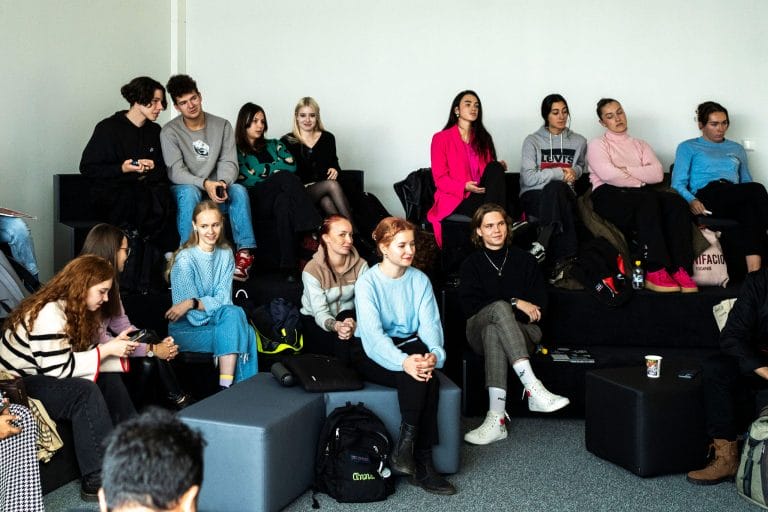
International talents of Kouvola

Work Life Path with Lumon
Practical training at Lumon Oy
Digital International Business student Rushitha Fonseka had the opportunity to do his advanced practical training at Lumon Oy in summer 2023. Watch the video about his positive experiences and how he was introduced to the company.
Practical training at the city of Kouvola and Kohoa Synergiakeskus
In the summer of 2024, the city of Kouvola employed two international students for human resources and communication tasks at the city hall, and for immigrant guidance and counseling tasks at MOONA. In addition, one student completed her internship at the Kohoa Synergiakeskus. In this video, the students talk about their summer experiences.
Events
🚀 Don’t miss the opportunity to unleash your potential with Patteri & Work Life Path! Join our Simulation of Interviews event on November 16th at 14.00 (Coffee at 13:30), Paja FUEL. Get insights from industry experts:
🔵 Liena Silen (Eezy Personnel):
- Introduction to Eezy Personnel
- Finnish work culture
- Interview etiquette
🔴 Saara Hirsto (Lumon):
- Introduction to Lumon
- Key traits sought in candidates
🎤Experience two interview simulation rounds: individual pitches and group interviews. Don’t worry; it’s all about your performance, so everyone has a fair chance!
Ready to shine in your future interviews? Secure your spot today – places are limited!

Looking for part-time job opportunities in Kouvola? Join the ‘International Talents of Kouvola’ event, where you can connect with renowned local recruitment agencies like Amiko, Eezy, and Työvoimaa. Engage with Inspiring Speakers:
▪️ Veronique Sanguinetti: “Innovational Entrepreneurship”
▪️ Angelika Polak and Ria Andrews: “Finnish Work Culture and Integration”
Discover how to integrate into Finnish work culture while exploring exciting part-time job prospects with Work-Life Path, JCI, and Patteri, funded by Otsakorven Säätiö.
The event is at Synergiakeskus Kohoa.
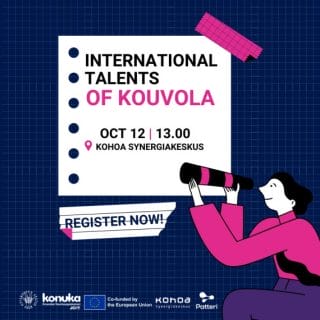
A seminar on how to find a decent job or practical training without losing your mind. The event is held at FUEL, Paja.
13.00 – 13.15 Opening the seminar; Riku Happonen, Project Manager, Xamk
13.15 – 14.15 LEAN Value Chain Leadership; Juha Ketola, Entrepreneur, Kauppavalmennus Oy
14.15 – 14.45 Lumon Opportunities; Saara Hirsto, Talent Acquisition Manager, Lumon Oy
14.45 – 15.15 Stora Enso Opportunities; Anne Ruohoniemi, HR Manager, Stora Enso
The seminar is the opening event of Työelämäpolku – KV-osaajat töihin ESR+ funded project. The project aims to create new practical training & thesis processes for international degree students with major company partners.
